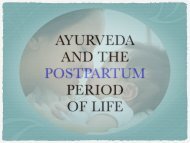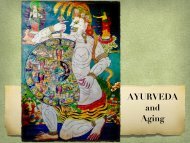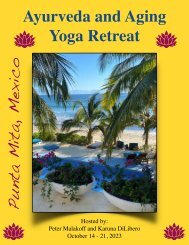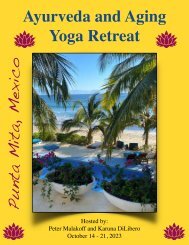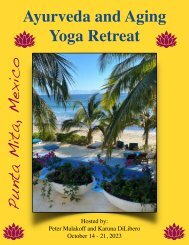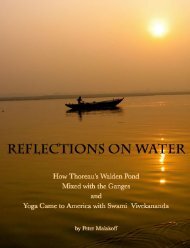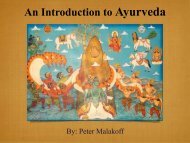THE CURE of the MUSTARD SEED
The story of a woman by the name of Kisagotami who came to Buddha carrying her dead child in her arms. She asked him to bring her baby back to life. Buddha asked her to bring him some mustard seed from a house in which no one had died. This is that story . . .
The story of a woman by the name of Kisagotami who came to Buddha carrying her dead child in her arms. She asked him to bring her baby back to life. Buddha asked her to bring him some mustard seed from a house in which no one had died. This is that story . . .
Create successful ePaper yourself
Turn your PDF publications into a flip-book with our unique Google optimized e-Paper software.
The Cure <strong>of</strong> <strong>the</strong> Mustard Seed<br />
A Little Book on Death, Dying<br />
and<br />
<strong>the</strong> Loss <strong>of</strong> All and Everything<br />
Peter Malak<strong>of</strong>f
Copyright © 2015 by Peter Malak<strong>of</strong>f<br />
All rights reserved.<br />
Peter Malak<strong>of</strong>f<br />
www.petermalak<strong>of</strong>fbooks.weebly.com<br />
The Cure <strong>of</strong> <strong>the</strong> mustard Seed<br />
by Peter Malak<strong>of</strong>f<br />
Title ID: 5050117<br />
ISBN-13: 978 150 7745 359
Looking up from <strong>the</strong> bottom <strong>of</strong> <strong>the</strong> steps at Manikarnika Ghat
To my parents<br />
who passed this way before me<br />
You always sought to gift <strong>the</strong> world with goodness<br />
May this help
Three bodies on <strong>the</strong> steps at Manikarnika Ghat
“This life disappears very quickly<br />
Like something written in water with a stick”<br />
— Buddha
View <strong>of</strong> Manikarnika Ghat
CONTENTS<br />
PROLOGUE . . . . . . . . . . . . . . . . . . . . . . . . . . . . . . . . . . . . . . . . . . . . . . . . . . . . . . 11<br />
ABOUT <strong>THE</strong> PICTURES . . . . . . . . . . . . . . . . . . . . . . . . . . . . . . . . . . . . . . . . . . . 17<br />
HOW TO USE THIS BOOK . . . . . . . . . . . . . . . . . . . . . . . . . . . . . . . . . . . . . . . . . 21<br />
PREFACE . . . . . . . . . . . . . . . . . . . . . . . . . . . . . . . . . . . . . . . . . . . . . . . . . . . . . . . . . . 23<br />
INTRODUCTION . . . . . . . . . . . . . . . . . . . . . . . . . . . . . . . . . . . . . . . . . . . . . . . . . 27<br />
<strong>THE</strong> <strong>CURE</strong> OF <strong>THE</strong> <strong>MUSTARD</strong> <strong>SEED</strong> . . . . . . . . . . . . . . . . . . . . . . . . . . . . . . . 41<br />
A MODERN DAY VERSION OF <strong>THE</strong> STORY . . . . . . . . . . . . . . . . . . . . . . . . . 59<br />
ABOUT <strong>THE</strong> AUTHOR . . . . . . . . . . . . . . . . . . . . . . . . . . . . . . . . . . . . . . . . . . . . 63<br />
O<strong>THE</strong>R BOOKS BY PETER MALAKOFF . . . . . . . . . . . . . . . . . . . . . . . . . . . . . 65
Pallbearers carrying a body down <strong>the</strong> steps to Manikarnika Ghat
PROLOGUE<br />
I spent <strong>the</strong> winter <strong>of</strong> 2004 in Banaras, India, <strong>the</strong> oldest still living city in<br />
<strong>the</strong> world. In <strong>the</strong> early mornings, I would walk <strong>the</strong> stone steps along <strong>the</strong><br />
Ganges from where I was living at Asi Ghat, to <strong>the</strong> ancient cremation<br />
grounds <strong>of</strong> Manikarnika Ghat. There I would devote a part <strong>of</strong> every<br />
day and evening at <strong>the</strong> burning ground.<br />
I witnessed a constant procession <strong>of</strong> once living people borne on<br />
bamboo stretchers by <strong>the</strong>ir male relations, brought down through <strong>the</strong><br />
narrow lanes <strong>of</strong> Benaras to where <strong>the</strong> alleys open up at stone steps that<br />
lead down to Manikarnika. There at <strong>the</strong> river, <strong>the</strong>y were ba<strong>the</strong>d one last<br />
time in <strong>the</strong> sacred Ganges, placed on a pyre <strong>of</strong> logs and consumed by<br />
flames; <strong>the</strong>ir elements separated to e<strong>the</strong>r, air, fire water and earth.<br />
11
The cremation ground at Manikarnika<br />
12
It was a place <strong>of</strong> tremendous power. The dead bodies all around me and <strong>the</strong><br />
constant burning <strong>of</strong> two-armed forms just like my own, confounded <strong>the</strong><br />
ideas <strong>of</strong> who or what I am.<br />
A veil was pulled back and I passed beyond <strong>the</strong> India I read <strong>of</strong> in <strong>the</strong><br />
ancient scriptures <strong>of</strong> <strong>the</strong> Ramayana, Mahabharata and Upanishads; <strong>the</strong><br />
India <strong>of</strong> Buddha, Shankara, Kabir, Lahiri Mahasaya and Trailinga Swami.<br />
I passed beyond <strong>the</strong> legends <strong>of</strong> Manikarnika and Lord Shiva’s promise <strong>of</strong><br />
liberation to whoever dies in Benaras. I no longer thought <strong>of</strong> <strong>the</strong> millions<br />
<strong>of</strong> people who for thousands <strong>of</strong> years have come to Manikarnika to die and<br />
be cremated, nor <strong>the</strong> haunting and timeworn architecture, stained by eons<br />
<strong>of</strong> cremation smoke from <strong>the</strong> burning ground and lled with <strong>the</strong> constant<br />
activity <strong>of</strong> death that takes place <strong>the</strong>re every day and night . . .<br />
Ra<strong>the</strong>r, I came into <strong>the</strong> presence <strong>of</strong> a timeless truth. I saw my own<br />
mortality and instantly understood; this is <strong>the</strong> truth that I always needed<br />
to see, this is <strong>the</strong> truth we all must see.<br />
13
Burning fire tended by a Dom– <strong>the</strong> caste that carries out cremations<br />
14
Death and suffering are <strong>the</strong> paradoxical keys to our desire for freedom;<br />
<strong>the</strong>y remain <strong>the</strong> inspiration beneath <strong>the</strong> idealism <strong>of</strong> my spiritual interest<br />
from <strong>the</strong> time I was a youth.<br />
Witnessing body after body consumed by fire and cease to exist, it was<br />
no longer possible to be consoled. I discovered <strong>the</strong> liberating medicine<br />
<strong>of</strong> <strong>the</strong> Mustard Seed, <strong>the</strong> ‘cure’ this story is about.<br />
“Many have died; you will also die<br />
The drum <strong>of</strong> death is being beaten<br />
The world has fallen in love with a dream<br />
Only <strong>the</strong> sayings <strong>of</strong> <strong>the</strong> wise will remain”<br />
– Bijak <strong>of</strong> Kabir<br />
15
Pallbearers traversing <strong>the</strong> last steps on <strong>the</strong>ir way down to <strong>the</strong> Ganges.<br />
16
ABOUT <strong>THE</strong> PICTURES<br />
Death is mostly hidden in <strong>the</strong> west and rarely seen. Even in <strong>the</strong> absence <strong>of</strong><br />
violence or accident, we consider death a terrible event, something better<br />
not to look at; yet as we all know, death is an inescapable part <strong>of</strong> life. I have<br />
been living in India for several years and like many o<strong>the</strong>r things in this<br />
country such as disease or poverty, <strong>the</strong> witnessing <strong>of</strong> death is a common<br />
occurrence. It begins with a loud beating <strong>of</strong> drums that noties everyone<br />
in <strong>the</strong> neighborhood that someone has died; <strong>the</strong>n a public display <strong>of</strong> <strong>the</strong><br />
deceased on a cot outside <strong>the</strong> house, <strong>the</strong> carrying <strong>of</strong> <strong>the</strong> corpse through<br />
<strong>the</strong> streets and alleys past houses and shops to cremation at <strong>the</strong> burning<br />
ground and all <strong>of</strong> it is in public view.<br />
I lived in Benaras for months and every single day and night, I saw dead<br />
bodies on bamboo biers carried down <strong>the</strong> narrow alleys to be<br />
cremated. As <strong>the</strong> procession passed <strong>the</strong> houses and shops you could hear<br />
<strong>the</strong> pallbearers chanting: Rama Nama Satya Hai, Sub ki Yahe Gate Hai.<br />
It means: “Only <strong>the</strong> name <strong>of</strong> God is Truth. This is <strong>the</strong> fate <strong>of</strong> all.”<br />
17
Wood brought in on boats for <strong>the</strong> cremation fires<br />
18
I took <strong>the</strong>se photographs at Manikarnika Ghat. I was befriended by<br />
one <strong>of</strong> <strong>the</strong> Doms, <strong>the</strong> caste that perform <strong>the</strong> cremations and he gave<br />
me permission to do this. Photographs are almost never allowed at<br />
Manikarnika and rarely taken, yet I was able to spend a whole day<br />
and evening on <strong>the</strong> burning ground capturing <strong>the</strong> scene on film; it<br />
was an unforgettable experience. I approached people with<br />
consideration and respect and usually <strong>the</strong>y motioned me in closer. In<br />
<strong>the</strong> midst <strong>of</strong> <strong>the</strong>ir own personal loss and <strong>the</strong> cremation <strong>of</strong> <strong>the</strong>ir<br />
relations, <strong>the</strong>y had no impulse to hide what was going on; this too was<br />
life and worthy <strong>of</strong> being seen and recorded.<br />
I wanted this story to be suitable for younger people. Aer much<br />
consideration, for <strong>the</strong> sake <strong>of</strong> wholeness and to bring visual reality to<br />
this teaching <strong>of</strong> <strong>the</strong> Buddha, I decided to put toge<strong>the</strong>r <strong>the</strong> pictures you<br />
see here (Originally, I was going to use thangkas <strong>of</strong> <strong>the</strong> Healing<br />
Buddha). I believe <strong>the</strong>se pictures od death are particularly necessary<br />
for those <strong>of</strong> us who live in <strong>the</strong> West; <strong>the</strong>y are reminders <strong>of</strong> <strong>the</strong> nature<br />
<strong>of</strong> <strong>the</strong> world we live in. ey are not intended to be terrible or<br />
frightening, <strong>the</strong>y are simply true.<br />
19
Last dip <strong>of</strong> <strong>the</strong> body in <strong>the</strong> Ganges at <strong>the</strong> bottom <strong>of</strong> <strong>the</strong> steps at Manikarnika<br />
20
HOW TO USE THIS BOOK<br />
When confronted with death we are oen overwhelmed by our own<br />
emotions; oen our grief is more for ourselves than for those who have<br />
died and even while we mourn, <strong>the</strong> beauty and wonder <strong>of</strong> life still goes<br />
on all around us. Is death a tragedy or a blessing? How should we feel<br />
or act when confronted with <strong>the</strong> n ality <strong>of</strong> death? Should we weep,<br />
rejoice, or both or nei<strong>the</strong>r? Because such questions arise, it is good to<br />
hear <strong>the</strong> wisdom <strong>of</strong> <strong>the</strong> Great Teachers and that is why I share this<br />
story.<br />
Perhaps you know a young person who is confronting death for <strong>the</strong> rst<br />
time. Read this story with <strong>the</strong>m, look at <strong>the</strong> pictures and consider what<br />
you have heard and seen. If you know an adult who is grieving, give<br />
<strong>the</strong>m <strong>the</strong> book or read it with <strong>the</strong>m. If you are distraught and saddened<br />
by loss, this story is medicine for your life. If you are feeling whole and<br />
balanced, this story may remind you <strong>of</strong> what is inevitable and what<br />
we all tend to forget.<br />
21
Body on <strong>the</strong> pyre<br />
22
PREFACE<br />
A friend <strong>of</strong> mine died when I was young. I remember going to his<br />
funeral and standing around his casket with <strong>the</strong> adults. Everybody<br />
seemed sad, embarrassed and uncomfortable. Like many young<br />
people, I was sensitive to this and greatly affected by <strong>the</strong><br />
experience. I wanted to find out more.<br />
Growing up in America, no one taught me anything about <strong>the</strong> end<br />
<strong>of</strong> life or what happens after someone dies. As I matured, I read<br />
many stories and beliefs about mortality in <strong>the</strong> different cultures<br />
and religions <strong>of</strong> <strong>the</strong> world. My exploration led me to those<br />
whose experience and understanding transcended belief and<br />
doubt and this is how I came to learn what <strong>the</strong> greatest <strong>of</strong><br />
Teachers, such as Krishna, Buddha and Jesus, said about death.<br />
23
Buildings and wood storage for <strong>the</strong> cremation fires<br />
(behind <strong>the</strong> burning grounds at Manikarnika)<br />
24
The Cure <strong>of</strong> <strong>the</strong> Mustard Seed is part <strong>of</strong> <strong>the</strong> Pali Canon, <strong>the</strong> original<br />
scripture <strong>of</strong> Buddhism. It relates an actual incident: a Mo<strong>the</strong>r brought<br />
her dead son to <strong>the</strong> Buddha and begged him to restore her child to<br />
life. Buddha responded by asking her to bring some ‘medicine,’ some<br />
mustard seed from a house in which no one had died. We will see how<br />
Buddha’s simple request conveyed his teaching and allowed a young<br />
woman in great grief to accept <strong>the</strong> inevitability <strong>of</strong> death and change her<br />
attitude towards living.<br />
Ananda, <strong>the</strong> most intimate friend and disciple <strong>of</strong> <strong>the</strong> Buddha, said that<br />
Buddha always taught in a way that was suitable for both children and<br />
adults. I have tried to follow that tradition in telling this story.<br />
“ A tomorrow when you are gone, is undoubtedly coming.”<br />
– Shura’s letter to Kanika<br />
25
Bathing <strong>the</strong> body one last time in <strong>the</strong> Ganges<br />
26
INTRODUCTION<br />
A Christian Missionary told a group <strong>of</strong> Cambodian children about <strong>the</strong><br />
miracle Jesus performed when he raised Lazarus from <strong>the</strong> dead. The<br />
children asked him whe<strong>the</strong>r Lazarus had later died. The Missionary<br />
replied, “Yes, Lazarus did eventually pass away.” The children thought<br />
about that and one <strong>of</strong> <strong>the</strong>m said, “Lord Buddha did not raise a man from<br />
<strong>the</strong> dead, but he did teach human beings to accept death and awaken<br />
beyond <strong>the</strong> cycles <strong>of</strong> living and dying.”<br />
In Buddhist culture, from <strong>the</strong> time <strong>the</strong>y are small, every child is taught:<br />
“Life is suffering. You will die. I will die. Everyone will die. All things<br />
will change, pass away and cease to be. Nothing is eternal.”<br />
This is not meant to be depressing, it is an important fact; a verity so<br />
important that Buddha proclaimed it as <strong>the</strong> “First Noble Truth,” when<br />
he gave his very first teaching, The Turning <strong>of</strong> <strong>the</strong> Wheel <strong>of</strong> Dharma,<br />
in <strong>the</strong> Deer Park at Sarnath, quite close to Benares where <strong>the</strong>se pictures<br />
were taken.<br />
27
Debris from previous cremations on <strong>the</strong> riverbank below Manikarnika<br />
28
In <strong>the</strong> original teaching <strong>of</strong> <strong>the</strong> Buddha, death is looked at directly.<br />
Practitioners understood that death cannot be ‘cured’ through any<br />
temporary extension <strong>of</strong> life, whe<strong>the</strong>r by Jesus, Buddha, medicine,<br />
technology, or belief in anything, whatsoever; nor is <strong>the</strong>re any real<br />
consolation from death. Buddha did not believe in <strong>the</strong> salvation <strong>of</strong><br />
<strong>the</strong> individual. The ‘solution’ he put forth is liberation from <strong>the</strong> false<br />
assumption <strong>of</strong> self. His was a teaching <strong>of</strong> Liberation, not salvation.<br />
Buddha taught that every aspect <strong>of</strong> life is touched by <strong>the</strong> fourfold ills<br />
<strong>of</strong> birth, sickness, old age and death. These co-dependently arising<br />
attributes are inevitable corrolaries <strong>of</strong> The First Noble Truth. Like <strong>the</strong><br />
sunlight in <strong>the</strong> morning that falls upon our bed, <strong>the</strong>y are teachers who<br />
make us interested in waking up. Because <strong>the</strong>se ‘fourfold ills’ are<br />
woven into <strong>the</strong> nature <strong>of</strong> our world, we will come to know <strong>the</strong>m, for<br />
one day it will be our turn to experience <strong>the</strong>m as well.<br />
It is always good to start with what is real, (although <strong>the</strong>re may be<br />
better or worse ways to express and understand it), for if we do not<br />
live with reality, one way or ano<strong>the</strong>r, reality will come to live with us.<br />
29
View from <strong>the</strong> bottom <strong>of</strong> <strong>the</strong> steps at Manikarnika looking towards burning ground.<br />
Here <strong>the</strong> bodies await <strong>the</strong>ir last bath in <strong>the</strong> Ganges before cremation.<br />
30
All <strong>the</strong> greatest Teachers considered death and all <strong>of</strong> <strong>the</strong>m pointed to<br />
an ultimate Reality or Truth that transcends <strong>the</strong> ending <strong>of</strong> <strong>the</strong> physical<br />
body. Buddha was born into <strong>the</strong> Hindu-Vedic culture <strong>of</strong> Nepal; a<br />
culture centered around <strong>the</strong> religious practices <strong>of</strong> sacrifice and<br />
worship, purposed to achieve various goals <strong>of</strong> <strong>the</strong> individual concerning<br />
heaven and earth.<br />
Buddha criticized <strong>the</strong> Hindu religious practice <strong>of</strong> his day. He pointed<br />
out that Vedic teaching and objectives were based on a false<br />
assumption; <strong>the</strong> existence <strong>of</strong> an individual self, and thus, even in <strong>the</strong><br />
best <strong>of</strong> circumstances, everything one might attain was threatened and<br />
would always result in suffering. Buddha acknowledged that a god or<br />
a rich person might have longer life, finer food, better clo<strong>the</strong>s,<br />
more exquisite pleasures and a nicer house, but that life, food, clo<strong>the</strong>s,<br />
pleasure and house will pass away one day and <strong>the</strong> god or person who<br />
experiences <strong>the</strong>m will grow old, become sick, die and lose everything.<br />
31
Three bodies on <strong>the</strong> steps awaiting cremation<br />
32
Buddha countered <strong>the</strong> soaring idealism <strong>of</strong> Hindu thought and religion<br />
with a realistically based teaching; he began not with <strong>the</strong> description<br />
<strong>of</strong> an ascended or idealistic goal, but with <strong>the</strong> nature <strong>of</strong> life itself,<br />
summarized in <strong>the</strong> First Noble Truth <strong>of</strong> Suffering.<br />
Buddha taught that death comes to everyone, animal, men and gods.<br />
Still, his teaching points to a Truth beyond death; a Reality that is<br />
always and already <strong>the</strong> case. According to <strong>the</strong> Buddha, <strong>the</strong>re is no<br />
individual self that is born or ever dies, but this is not something<br />
he asked people to believe in. He never suggested it is possible to<br />
be consoled, but that it is possible to be free, and this freedom is a<br />
Truth that must be realized. For <strong>the</strong> sake <strong>of</strong> this realization<br />
and to motivate people towards it, <strong>the</strong> first thing Buddha does<br />
is to confront his listeners with <strong>the</strong> link between <strong>the</strong> assumption<br />
<strong>of</strong> self and <strong>the</strong> painful reality <strong>of</strong> <strong>the</strong> world. In one <strong>of</strong> his famous<br />
talks called <strong>the</strong> Fire Sermon, he points out that everything in<br />
life is literally burning.<br />
33
Cremation <strong>of</strong> body being tended by a Dom<br />
34
The ‘burning’ <strong>of</strong> desire, attraction, aversion, delusion, birth, sickness, old<br />
age and death and all <strong>the</strong> psychological pain that goes along with <strong>the</strong>m;<br />
<strong>the</strong>se are what cause us to seek relief in physical pleasure, religion or even<br />
enlightenment.<br />
Before Buddha speaks <strong>of</strong> <strong>the</strong> <strong>of</strong> <strong>the</strong> Second Noble Truth <strong>of</strong> <strong>the</strong> Origin <strong>of</strong><br />
Suffering in craving or desire, <strong>the</strong> Third Noble Truth regarding <strong>the</strong> End <strong>of</strong><br />
Suffering or <strong>the</strong> Fourth Noble Truth <strong>of</strong> <strong>the</strong> Way that leads to <strong>the</strong> Cessation<br />
<strong>of</strong> Suffering, Buddha expounds <strong>the</strong> First Noble Truth <strong>of</strong> Suffering. This is<br />
because if <strong>the</strong> nature <strong>of</strong> life as suffering is not fully felt and recognized,<br />
if we have no sympathy with <strong>the</strong> burning nature <strong>of</strong> life, <strong>the</strong>n we have not<br />
awakened to reality; we still live in illusion and thus <strong>the</strong> religious path<br />
cannot truly begin, nor ever be accomplished.<br />
“Your life dwells among <strong>the</strong> causes <strong>of</strong> death<br />
Like a lamp standing in a strong breeze.”<br />
– Nagarjuna<br />
35
Body about to be cremated<br />
36
In <strong>the</strong> East, it is said <strong>the</strong>re are two wings to <strong>the</strong> bird <strong>of</strong> wisdom. One<br />
wing is <strong>the</strong> wing <strong>of</strong> experience. If we do not experience something,<br />
we cannot know it. It does not matter whe<strong>the</strong>r we believe in an idea<br />
or not, we must experience it for ourselves. However, even if we do<br />
experience something, that is still only one wing <strong>of</strong> <strong>the</strong> bird. With<br />
only one wing a bird cannot fly; it only goes around in circles on <strong>the</strong><br />
ground. The second wing <strong>of</strong> <strong>the</strong> bird is understanding, or <strong>the</strong> story by<br />
which we interpret and understand our experience.<br />
If <strong>the</strong> story we hear is not accurate or true, regardless <strong>of</strong> what we have<br />
experienced, we cannot gain wisdom. If we consider <strong>the</strong> map <strong>of</strong> our<br />
lives according to an inaccurate legend, we will follow roads that go<br />
nowhere and waste our lives imagining and reacting to things that are<br />
not true.<br />
Buddha taught that while everyone will suffer, not all suffering is<br />
necessary. A good story, <strong>the</strong> teaching <strong>of</strong> Truth, an accurate<br />
description <strong>of</strong> Reality, can go a long way to eliminate unnecessary<br />
suffering. The Cure <strong>of</strong> Mustard Seed is one such story.<br />
37
View <strong>of</strong> corpse and buildings behind Manikarnika Ghat<br />
38
The Cure <strong>of</strong> The Mustard Seed clarifies <strong>the</strong> mind and heals <strong>the</strong> heart.<br />
It affirms that life is suffering and death an inescapable result <strong>of</strong> being<br />
born. This may seem a simple observation, but, Buddha proclaimed<br />
it to be a great and ’Noble Truth’. However, it is a truth that must<br />
be realized; only realization, (not belief, doubt, acceptance or<br />
intellectual sympathy), frees one from <strong>the</strong> cycles <strong>of</strong> birth and death.<br />
All <strong>of</strong> us are seeking a remedy for suffering. This is <strong>the</strong> search at <strong>the</strong><br />
core <strong>of</strong> every human being and <strong>of</strong> every religion. Whatever we<br />
believe, whatever faith we belong to, even if we belong to none at all,<br />
we must pass beyond both belief and doubt and deal with reality.<br />
Therefore, before we turn our attention to what we think we are<br />
seeking, we must begin with what motivates us towards our chosen<br />
goal or remedy . . . <strong>the</strong> reality <strong>of</strong> suffering.<br />
This story begins with <strong>the</strong> refusal to accept death and ends with <strong>the</strong><br />
understanding <strong>of</strong> <strong>the</strong> inevitable suffering <strong>of</strong> life. It presents <strong>the</strong><br />
Teaching <strong>of</strong> <strong>the</strong> Buddha with a parable in which we recognize a<br />
troublesome Truth about our own life and <strong>the</strong> life <strong>of</strong> every<br />
being. Listen and you will learn <strong>the</strong> healing power <strong>of</strong> simple<br />
mustard seed . . .<br />
39
Buddha Teaching his disciples - Chinese Thangka<br />
40
<strong>THE</strong> <strong>CURE</strong> OF <strong>THE</strong> <strong>MUSTARD</strong> <strong>SEED</strong><br />
Once, long ago, when Gautama Buddha was speaking with monks and<br />
nuns in <strong>the</strong> forest <strong>the</strong>re was a disturbance in <strong>the</strong> back <strong>of</strong> <strong>the</strong> small group<br />
assembled.<br />
There appeared a young woman, Kisagotami by name, weeping and<br />
distressed and carrying a small dead child in her arms. Kisagotami was<br />
seeking for someone to restore her baby to life. Her little boy had died<br />
and she had gone to all her neighbors seeking some medicine, but <strong>the</strong>y<br />
thought she was mad. Finally, a wise old man said to her, “I do not have<br />
<strong>the</strong> medicine you need, but I know a physician who does.” The young<br />
woman said: “Oh please tell me sir; who is this person?” And <strong>the</strong> man<br />
replied: “Go to <strong>the</strong> Buddha. He will help you.”<br />
Kisagotami hastened to <strong>the</strong> forest and came to where <strong>the</strong> Buddha sat.<br />
Bowing before him she cried, “Oh Lord Buddha, please, I pray you,<br />
help me!”<br />
41
Kisagotami in front <strong>of</strong> <strong>the</strong> Buddha<br />
42
The Buddha asked her, “What is it that you desire?”<br />
“My child, this boy that I carry in my arms, has died,” cried <strong>the</strong> woman.<br />
“I beg you, bring him back to life.”<br />
A gasp went through <strong>the</strong> assembly, as people heard what she had<br />
requested. They had seen many miracles around <strong>the</strong> Buddha. But, his<br />
teaching was one <strong>of</strong> understanding and realization, not <strong>of</strong> miraculous<br />
cures or powers.<br />
Buddha sat quietly for a moment and <strong>the</strong>n said: “Bring me some<br />
mustard seed from a house in which no one has lost a parent, a child, a<br />
husband, wife or friend.”<br />
43
Small Indian Village near Benaras<br />
44
Kisagotami was relieved at <strong>the</strong> simplicity <strong>of</strong> <strong>the</strong> task. This was remarkably<br />
easy and something she could immediately accomplish. “I shall do as you<br />
ask,” she replied. Then, taking her dead child with her, she hurried <strong>of</strong>f<br />
to <strong>the</strong> village to seek <strong>the</strong> mustard seed.<br />
Now in India, mustard seed is one <strong>of</strong> <strong>the</strong> most common <strong>of</strong> things. It is like<br />
salt or sugar in a home in <strong>the</strong> West today.<br />
45
Woman standing at <strong>the</strong> doorway <strong>of</strong> her house<br />
46
Kisagotami went up to <strong>the</strong> first house she saw. Bowing at <strong>the</strong> door to <strong>the</strong><br />
woman who stood <strong>the</strong>re, she asked, “Do you have any mustard seed?<br />
Please, do you have any mustard seed?” The lady <strong>of</strong> <strong>the</strong> house saw<br />
<strong>the</strong> urgency <strong>of</strong> <strong>the</strong> young woman’s request and went to fetch some<br />
mustard seed. She brought it back and gave it to Kisagotami, pouring<br />
it into her hands. “Here my child. May it give you respite from all that<br />
ails you.”<br />
Kisagotami hardly thanked her, so excited was she to receive <strong>the</strong><br />
mustard seed. Her child could come back to life! But, as she hurried<br />
back to <strong>the</strong> Buddha she remembered <strong>the</strong> last part <strong>of</strong> his instructions; she<br />
needed to bring <strong>the</strong> mustard seed from a house in which <strong>the</strong>re had been<br />
no death and she had forgotten to ask! Kisagotami immediately turned<br />
around and went back to <strong>the</strong> woman who still stood at her doorway.<br />
“Please,” Kisagotami said, “Has anyone ever died in your house?”<br />
47
Man about to cast a pot <strong>of</strong> Ganges water over his left shoulder onto <strong>the</strong> cremation<br />
fire <strong>of</strong> his relative. After <strong>the</strong> pot breaks on <strong>the</strong> smoldering fire he is finished with<br />
<strong>the</strong> body. Then, he walks away and does not look back.<br />
48
“Oh yes, my child. Only last year my mo<strong>the</strong>r died. But why do you<br />
ask?” “Oh, I cannot take your mustard seed,” Kisagotami said. And she<br />
poured <strong>the</strong> seed back into <strong>the</strong> woman’s hands and hurried <strong>of</strong>f to <strong>the</strong> next<br />
house.<br />
There, Kisagotami again asked for mustard seed. The mistress <strong>of</strong> <strong>the</strong><br />
house brought her some and before she received it, Kisagotami asked,<br />
“Has anyone ever died in your house?” “Yes, my husband died here two<br />
years ago.” Here, too, she could not take <strong>the</strong> mustard seed.<br />
At <strong>the</strong> next house, <strong>the</strong>y had mustard seed. But, when Kisagotami asked<br />
if anyone had ever died in <strong>the</strong> house, she heard, “We lost our parents<br />
only this year.” At ano<strong>the</strong>r house a mo<strong>the</strong>r said, “My daughter died only<br />
last month.”<br />
Time after time, Kisagotami received similar answers; although in every<br />
household <strong>the</strong>re was mustard seed, in every household <strong>the</strong>re had been<br />
death.<br />
She realized that death comes to all beings and <strong>the</strong> dead are more<br />
plentiful than <strong>the</strong> living.<br />
49
Body being placed on <strong>the</strong> pyre for cremation<br />
50
Finally, Kisagotami accepted <strong>the</strong> death <strong>of</strong> her own child. Later that<br />
evening, she went deep into <strong>the</strong> forest and left her dead baby.<br />
The next day she returned to <strong>the</strong> Buddha. He asked her, “Have you<br />
brought any mustard seed?”<br />
“No,” she replied, “I could not find a house in which no one had died. I<br />
have buried my child in <strong>the</strong> forest.”<br />
The Buddha said:<br />
“The life <strong>of</strong> mortals in this world is troubled and brief and combined<br />
with pain. For <strong>the</strong>re is not any means by which those that have been<br />
born can avoid dying; after reaching old age <strong>the</strong>re is death; <strong>of</strong> such a<br />
nature are living beings. As ripe fruits are early in danger <strong>of</strong> falling,<br />
so mortals when born are always in danger <strong>of</strong> death. As all ear<strong>the</strong>n<br />
vessels made by <strong>the</strong> potter end up being broken, so is <strong>the</strong> life <strong>of</strong> mortals.<br />
Both young and old, both those who are fools and those who are wise,<br />
all fall into <strong>the</strong> hands <strong>of</strong> death; all are subject to death.<br />
51
Cremation fires burning<br />
52
“A fa<strong>the</strong>r cannot save his son, nor kinsmen, <strong>the</strong>ir relations. Look!<br />
While relatives are crying and lamenting deeply, one by one mortals<br />
are carried <strong>of</strong>f, like oxen led to <strong>the</strong> slaughter. So <strong>the</strong> world is afflicted<br />
with death and decay, <strong>the</strong>refore <strong>the</strong> wise do not grieve, knowing <strong>the</strong><br />
laws <strong>of</strong> <strong>the</strong> world. In whatever manner people think a thing will come<br />
to pass, it is <strong>of</strong>ten different when it happens, and great is <strong>the</strong><br />
disappointment; see, such are <strong>the</strong> ways <strong>of</strong> <strong>the</strong> world.<br />
“Not from weeping nor from grieving will any one obtain peace <strong>of</strong><br />
mind; on <strong>the</strong> contrary, his pain will be made greater and his body<br />
will suffer. He will make himself sick and pale and still <strong>the</strong> dead are<br />
not saved by his lamentations. People pass away, and <strong>the</strong>ir fate after<br />
death will be according to <strong>the</strong>ir deeds. If a person lives a hundred<br />
years, or even more, he will at last be separated from <strong>the</strong> company <strong>of</strong><br />
his relatives and loved ones, and leave <strong>the</strong> life <strong>of</strong> this world. He who<br />
seeks peace should draw out <strong>the</strong> arrow <strong>of</strong> lamentation, complaint<br />
and grief<br />
53
View <strong>of</strong> <strong>the</strong> burning grounds<br />
54
Kisagotami realized whatever arises will cease to be. Her mind became<br />
clear and her eyes were opened. Convinced <strong>of</strong> <strong>the</strong> First Noble Truth, she<br />
entered <strong>the</strong> stream <strong>of</strong> <strong>the</strong> way that leads to Nirvana.<br />
“Better than a hundred years in <strong>the</strong> life <strong>of</strong> a person who does not<br />
perceive <strong>the</strong> Deathless State <strong>of</strong> Nirvana, is a day in <strong>the</strong> life <strong>of</strong> one<br />
who perceives <strong>the</strong> Deathless State <strong>of</strong> Nirvana.”<br />
This true story is called: The Cure <strong>of</strong> <strong>the</strong> Mustard Seed.<br />
55
Three bodies on <strong>the</strong> steps at Manikarnika:’<strong>the</strong> living and <strong>the</strong> dead’<br />
56
The first Teaching <strong>of</strong> <strong>the</strong> Buddha as well as <strong>the</strong> last words he spoke,<br />
dealt with <strong>the</strong> reality <strong>of</strong> death. The First Noble Truth, stated that all life<br />
was dukkha or suffering.<br />
Just before he died, <strong>the</strong> Buddha returned to a similar <strong>the</strong>me:<br />
“Behold, O’ monks, this is my last advice to you. All component<br />
things in <strong>the</strong> world are changeable. They are not lasting. Strive to<br />
work out your own salvation.”<br />
Buddha taught that although everyone dies, no one is dead. It may<br />
be comforting to believe in this, but, it is a great Truth that must be<br />
Realized.<br />
The root <strong>of</strong> Realization is <strong>the</strong> First Noble Truth <strong>of</strong> Suffering. To<br />
Realize <strong>the</strong> nature <strong>of</strong> life is a great blessing for <strong>the</strong> living and <strong>the</strong> dead<br />
and that is <strong>the</strong> message <strong>of</strong> this book.<br />
57
Ramana Maharshi<br />
58
A MODERN DAY VERSION OF <strong>THE</strong> STORY<br />
I live part <strong>of</strong> <strong>the</strong> year at <strong>the</strong> foot <strong>of</strong> <strong>the</strong> holy mountain, Arunachala, in<br />
Tiruvannamalai, Tamil Nadu, home <strong>of</strong> <strong>the</strong> ashram <strong>of</strong> Ramana Maharshi<br />
(1879-1950), one <strong>of</strong> <strong>the</strong> greatest saints <strong>of</strong> <strong>the</strong> twentieth century. Like <strong>the</strong><br />
Buddha, Ramana or ‘Bhagavan’ was asked a similar question by a<br />
distraught mo<strong>the</strong>r; here is that story, told by Vajreswari, <strong>the</strong> daughter <strong>of</strong><br />
Ganapati Muni:<br />
“Once a devotee brought her dead son in a box and prayed intensely<br />
to Bhagavan to bring him back to life. Bhagavan could readily see <strong>the</strong><br />
faith and hope behind her prayer. Tenderly, he told her, Amma (Mo<strong>the</strong>r),<br />
don’t you see that if I restore your son’s life, Sri Ramanashram would<br />
be flooded with corpses? Then he spoke to her at length about life,<br />
death and <strong>the</strong> need to be conscious <strong>of</strong> <strong>the</strong> state transcending both. He<br />
explained that all experiences were centered around <strong>the</strong> individual and<br />
that <strong>the</strong> search for <strong>the</strong> source <strong>of</strong> <strong>the</strong> self alone would end all suffering.<br />
59
Ramana Maharshi<br />
60
These soothing words and advice went home and <strong>the</strong> lady returned, consoled at<br />
heart. This was only natural since Bhagavan’s words were loaded with power<br />
and grace. After <strong>the</strong> lady left, a devotee asked, “Is it possible to revive <strong>the</strong> dead?<br />
Bhagavan replied, Jnani’s, siddhas and yogis can restore life, but is it for this<br />
purpose that <strong>the</strong>y have come?”<br />
— Face to Face with Ramana Maharshi<br />
61
Peter Malak<strong>of</strong>f<br />
62
ABOUT <strong>THE</strong> AUTHOR<br />
I have been a Religious Studies scholar, poet, Ayurvedic consultant,<br />
Ghee Maker, woodworker, teacher and writer. For <strong>the</strong> past several<br />
years, I resided in <strong>the</strong> high foothills <strong>of</strong> <strong>the</strong> Himalaya near<br />
Ladakh during <strong>the</strong> spring, summer and fall and <strong>the</strong>n, as <strong>the</strong><br />
wea<strong>the</strong>r turns cold, travel south to Tiruvannamalai, Tamil Nadu, to<br />
live near <strong>the</strong> ashram <strong>of</strong> Ramana Maharshi where I stay for <strong>the</strong> winter<br />
months.<br />
I have been in this ancient land for only a few years and am gracefully<br />
drowning in <strong>the</strong> ocean <strong>of</strong> wisdom Realized by <strong>the</strong> great Beings that<br />
once lived here and <strong>the</strong> stories <strong>the</strong>y have told.<br />
Mark Twain called India, “ . . . <strong>the</strong> cradle <strong>of</strong> <strong>the</strong> human race, <strong>the</strong><br />
birthplace <strong>of</strong> human speech, <strong>the</strong> mo<strong>the</strong>r <strong>of</strong> history, <strong>the</strong> grandmo<strong>the</strong>r<br />
<strong>of</strong> legend, and <strong>the</strong> great grandmo<strong>the</strong>r <strong>of</strong> tradition; our most valuable<br />
and most instructive materials in <strong>the</strong> history <strong>of</strong> man are treasured up<br />
in India” . . . this is but one <strong>of</strong> <strong>the</strong>m.<br />
63
Trash and Debris from <strong>the</strong> cremation ground in <strong>the</strong> Ganges<br />
64
O<strong>THE</strong>R BOOKS BY PETER MALAKOFF<br />
How Thoreau’s Walden Pond Mixed with <strong>the</strong> Ganges and Yoga Came<br />
to America with Swami Vivekananda (2012) (Apple ibook)<br />
The Man Who Built <strong>the</strong> Taj Mahal (2015)<br />
Manikarnika Ghat (2015)<br />
A Hanuman Story for Ram Dass (2019)<br />
Misericords: The Return <strong>of</strong> <strong>the</strong> Repressed (2019)<br />
Tragedy Fate and Nemesis (2017)<br />
Line Drawing <strong>of</strong> Kisagotami in front <strong>of</strong> <strong>the</strong> Buddha by Juhiro Mashiko<br />
All photographs <strong>of</strong> Manikarnika Ghat by Peter Malak<strong>of</strong>f<br />
Peter Malak<strong>of</strong>f<br />
http://www.petermalak<strong>of</strong>f.com<br />
petermalak<strong>of</strong>f@gmail.com<br />
65
Corpse on pyre<br />
66
67





